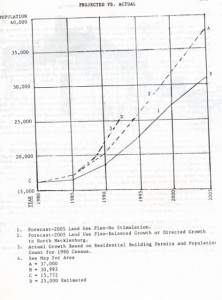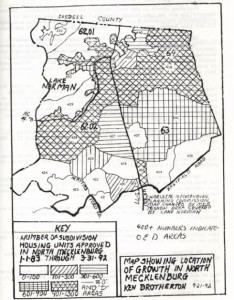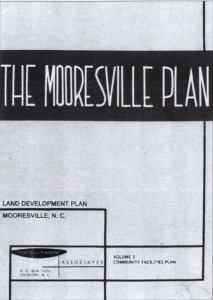-1960s-1970s-
On Displacement:

“Lake Norman provides a dependable supply of water to Lincoln, Davidson, Mooresville, Chalotte-Mecklenburg, and Huntersville, North Carolina. (Courtesy of Duke Energy).”
Prior to the building of Lake Norman, the Davidson area was predominantly characterized by agricultural farms. For twenty to thirty years the population remained stagnant until the construction of the lake. The lack of job opportunities and housing drove younger folks away from the area. However, the building of the lake changed the trajectory of population growth for North Mecklengburg. In the 1960’s population growth was mostly concentrated around the lake front properties with apartment and condominium projects booming.
Farmers were forced to move as the introduction of the lake took over their livelihoods. Families that held land for generations were forced to sell their land and move elsewhere. John Wally, a Lake Norman farmer felt like “he was like a displaced person in a foreign land.” Farmers were encouraged to sell their land in order to avoid “rumination of their crops and livestock” to be caused by the introduction of a future coal-burning plant expected to generate soot. However, Duke power decided against the coal burning plant, and when community leaders asked if they can re-buy their land it was being sold at $1000 per acre, a price farmers deemed “crazy” leaving them no option but to wait for prices to decrease.
-1980-1990s-
On Population Growth:
North Mecklenburg’s initial slow population growth was primarily due to the large families, and small farms that characterized its landscape. The farms were generally too small to be economically viable which drove plenty of families away from the farms and into the cities. After the introduction of the lake, families were further driven away from the area.

Graph of the projected Mecklenburg population growth versus the actual growth based on 1990 census data.
North Mecklenburg, however, experienced one of the fastest growth rates in North Carolina with a growing rate of 17% from 1988 to 1989. During a 10-year period, from 1980 to 1990, approximately 4,454 units of residential permits were issued in North Mecklenburg, 78% of which occurred within a 5-year period.
The introduction of Lake Norman was not the sole reason populations increased for the town of Davidson and Cornelius. Though new housing developments with waterfront views were an impetus, it was soon common knowledge that using I-77 North Mecklenburg conveniently placed downtown Charlotte thirty minutes away.
Development Plans
In 1984-85 a committee was formed to commission a land-use plan for Mecklenburg County where they divided seven planning areas. Eight categories of development took place after the lake’s introduction: Resort residential, urban residential, agricultural residential, access areas, commercial access areas, commercial, industrial and flood plains. The objective of this committee was to develop plans for the area and strategies for its growth through the year 2005. With this development plan in place, population growth results were apparent by 1988.
In 1985-1987 the Mecklenburg 20 Year County Land Use Plan was reviewed and modified to direct growth into northern Mecklenburg County via infrastructure and zoning. Towards the end of 1988 population curves increased so that the 1990 census count was 22,220 with 87.5% of its population being Caucasian. The heaviest concrentrations of growth took place on the peripheries of Lake Norman, as can be seen in the map above.
Davidson and Cornelius
Davidson has historically sided with remaining a small town, priding itself in its historical significance and preserved quaint character. Cornelius, though similar to Davidson, encourages the growth of its town. Increasing populations have placed a high demand for development of these towns, a change that may come at the cost of losing the town’s distinct identities.
Cornelius has become more commercialized than Davidson. Market conditions then drive Davidson residents into Cornelius, where the town is becoming increasingly commercialized. Each of these towns’ individual characteristics are threatened by increasing populations and their resource demands.
Lincoln County
Unlike the other side of the lake, Lincoln County did not experience the influx of wealth that accompanied Lake property. Newspapers indicate that Lincoln County was equally excited about the prospect of new development from the lake as the east side, yet the actual results of development were much different.
Mooresville
In Mooresville, the “Mooresville Plan” was set forth as a means to develop the area with the modernization of buildings, the development of a pedestrian mall, and installation of canopies over sidewalks. The town promoted its amenities to visitors that frequented the lake, attracting more and more people to the area.
Brotherton, Ken. Lake Norman–Piedmont History. Davidson, N.C. (138 Meadowbrook Lane, P.O. Box 62 Davidson 28036): K. Brotherton, 1993. Print.
Jacobs, Cindy. Around Lake Norman. Charleston, SC: Arcadia Pub., 2008. Print.




Speak Your Mind